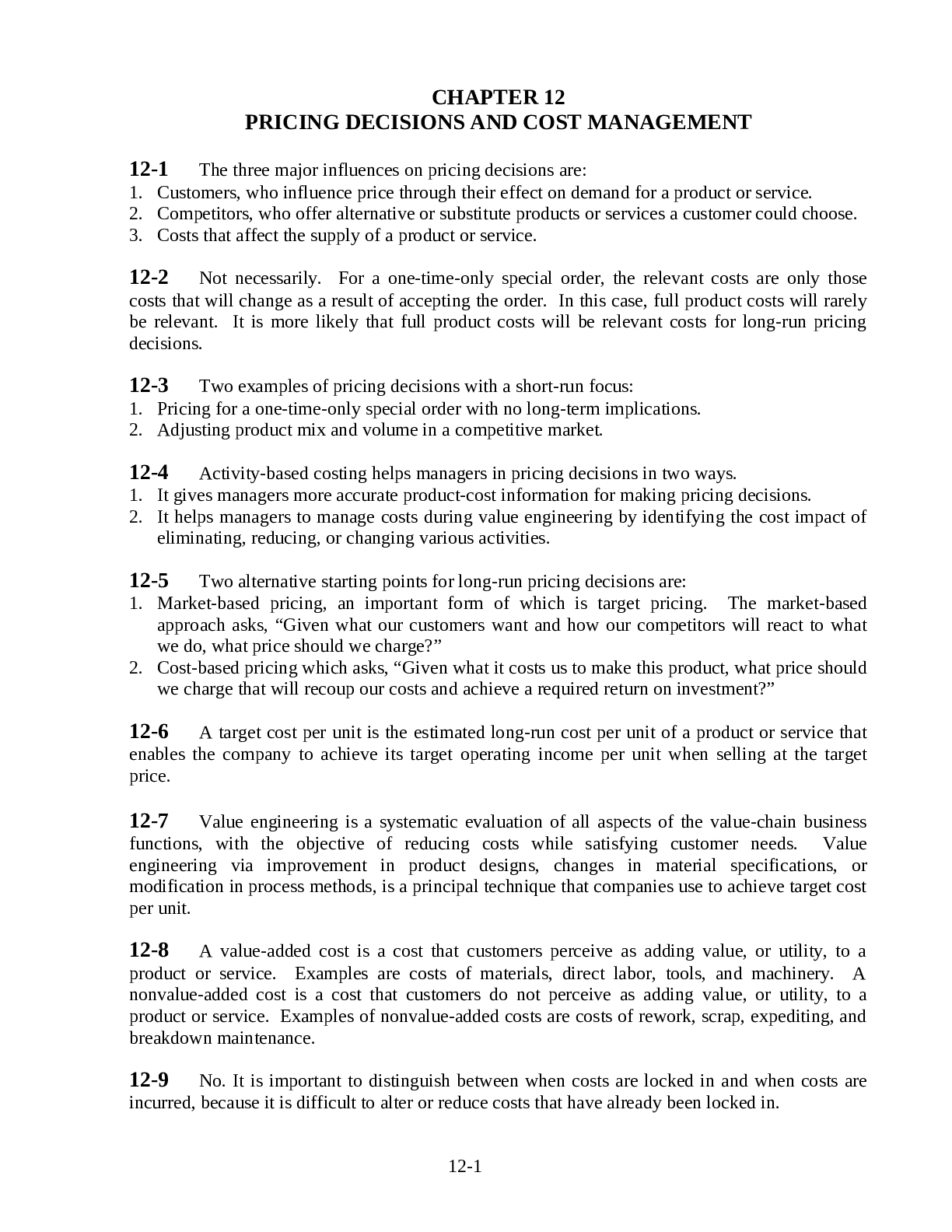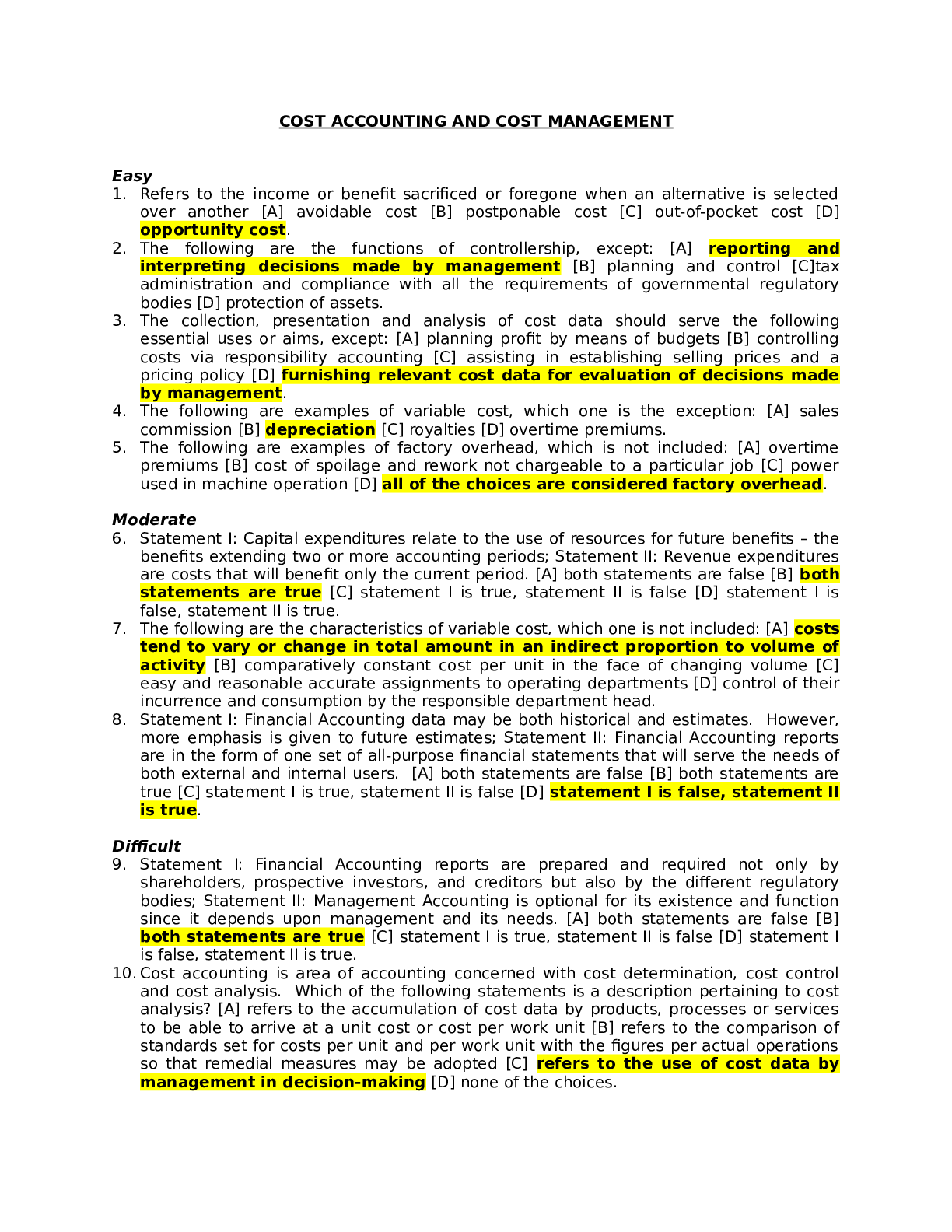Business > QUESTIONS & ANSWERS > PRICING DECISIONS AND COST MANAGEMENT Seton Hall University - BACC 7114HORN_Ch13_SM (All)
PRICING DECISIONS AND COST MANAGEMENT Seton Hall University - BACC 7114HORN_Ch13_SM
Document Content and Description Below
CHAPTER 13 PRICING DECISIONS AND COST MANAGEMENT 13-1 What are the three major influences on pricing decisions? The three major influences on pricing decisions are 1. Customers 2. Competitors 3.... Costs 13-2 “Relevant costs for pricing decisions are full costs of the product.” Do you agree? Explain. Not necessarily. For a one-time-only special order, the relevant costs are only those costs that will change as a result of accepting the order. In this case, full product costs will rarely be relevant. It is more likely that full product costs will be relevant costs for long-run pricing decisions. 13-3 Describe four purposes of cost allocation. Four purposes of cost allocation are as follows: 1. To provide information for economic decisions 2. To motivate managers and other employees 3. To justify costs or compute reimbursement amounts 4. To measure income and assets 13-4 How is activity-based costing useful for pricing decisions? Activity-based costing helps managers in pricing decisions in two ways. 1. It gives managers more accurate product-cost information for making pricing decisions. 2. It helps managers to manage costs during value engineering by identifying the cost impact of eliminating, reducing, or changing various activities. 13-5 Describe two alternative approaches to long-run pricing decisions. Two alternative approaches to long-run pricing decisions are the following: 1. Market-based pricing, an important form of which is target pricing. The market-based approach asks, “Given what our customers want and how our competitors will react to what we do, what price should we charge?” 2. Cost-based pricing which asks, “What does it cost us to make this product and, hence, what price should we charge that will recoup our costs and achieve a target return on investment?” 13-6 What is a target cost per unit? A target cost per unit is the estimated long-run cost per unit of a product (or service) that, when sold at the target price, enables the company to achieve the targeted operating income per unit. 13-7 Describe value engineering and its role in target costing. Value engineering is a systematic evaluation of all aspects of the value-chain business functions, with the objective of reducing costs while satisfying customer needs. Value engineering via 13-1improvement in product and process designs is a principal technique that companies use to achieve target cost per unit. 13-8 Give two examples of a value-added cost and two examples of a non-value-added cost. A value-added cost is a cost that customers perceive as adding value, or utility, to a product or service. Examples are costs of materials, direct labor, tools, and machinery. A nonvalue-added cost is a cost that customers do not perceive as adding value, or utility, to a product or service. Examples of nonvalue-added costs are costs of rework, scrap, expediting, and breakdown maintenance. 13-9 “It is not important for a company to distinguish between cost incurrence and locked-in costs.” Do you agree? Explain. No. It is important to distinguish between when costs are locked in and when costs are incurred because it is difficult to alter or reduce costs that have already been locked in. 13-10 What is cost-plus pricing? Cost-plus pricing is a pricing approach in which managers add a markup to cost in order to determine price. 13-11 Describe three alternative cost-plus pricing methods. Cost-plus pricing methods vary with the bases used to calculate prices. Examples are (a) variable manufacturing costs; (b) manufacturing function costs; (c) variable product costs; and (d) full product costs. 13-12 Give two examples in which the difference in the costs of two products or services is much smaller than the difference in their prices. Two examples where the difference in the costs of two products or services is much smaller than the differences in their prices are: 1. The difference in prices charged for a telephone call, hotel room, or car rental during busy versus slack periods is often much greater than the difference in costs to provide these services. 2. The difference in costs for an airplane seat sold to a passenger traveling on business or a passenger traveling for pleasure is roughly the same. However, airline companies price discriminate. They routinely charge business travelers––those who are likely to start and complete their travel during the same week excluding the weekend––a much higher price for the same class of service than pleasure travelers who generally stay at their destinations over at least one weekend. 13-13 What is life-cycle budgeting? Life-cycle budgeting is an estimate of the revenues and costs attributable to each product from its initial R&D to its final customer servicing and support. 13-14 What are three benefits of using a product life-cycle reporting format? Three benefits of using a product life-cycle reporting format are the following: 1. The full set of revenues and costs associated with each product becomes more visible. 13-22. Differences among products in the percentage of total costs committed at early stages in the life cycle are highlighted. 3. Interrelationships among business function cost categories are highlighted. 13-15 Define predatory pricing, dumping, and collusive pricing. Predatory pricing occurs when a business deliberately prices below its costs in an effort to drive competitors out of the market and restrict supply and then raises prices rather than enlarge demand. Under U.S. laws, dumping occurs when a non-U.S. company sells a product in the United States at a price below the market value in the country where it is produced, and this lower price materially injures or threatens to materially injure an industry in the United States. Collusive pricing occurs when companies in an industry conspire in their pricing and production decisions to achieve a price above the competitive price and so restrain trade. 13-16 Which of the following statements regarding price elasticity is incorrect? a. A product with a perfectly inelastic demand would have the same demand even as prices change. b. A product with a perfectly inelastic demand would see demand change as prices change. c. When demand is price elastic, lower prices stimulate demand. d. When demand is price elastic, higher prices reduce demand. SOLUTION Choice "b" is the correct answer. The statement is incorrect because a product with a perfectly inelastic demand would not see demand change as prices change.Choice "a" is incorrect. This statement is true. Perfectly inelastic demand indicates that the demand will stay nearly the same as prices change.Choice "c" is incorrect. This statement is true. When demand is price elastic, lower prices stimulate demand (and profit). Choice "d" is incorrect. This statement is true. When demand is price elastic, higher prices reduce demand. 13-17 Value-added, non-value-added costs. The Magill Repair Shop repairs and services machine tools. A summary of its costs (by activity) for 2017 is as follows: a. Materials and labor for servicing machine tools $1,100,000 b. Rework costs 90,000 c. Expediting costs caused by work delays 65,000 d. Materials-handling costs 80,000 e. Materials-procurement and inspection costs 45,000 [Show More]
Last updated: 2 years ago
Preview 1 out of 50 pages

Buy this document to get the full access instantly
Instant Download Access after purchase
Buy NowInstant download
We Accept:

Reviews( 0 )
$9.00
Can't find what you want? Try our AI powered Search
Document information
Connected school, study & course
About the document
Uploaded On
Apr 21, 2021
Number of pages
50
Written in
Additional information
This document has been written for:
Uploaded
Apr 21, 2021
Downloads
0
Views
49
















